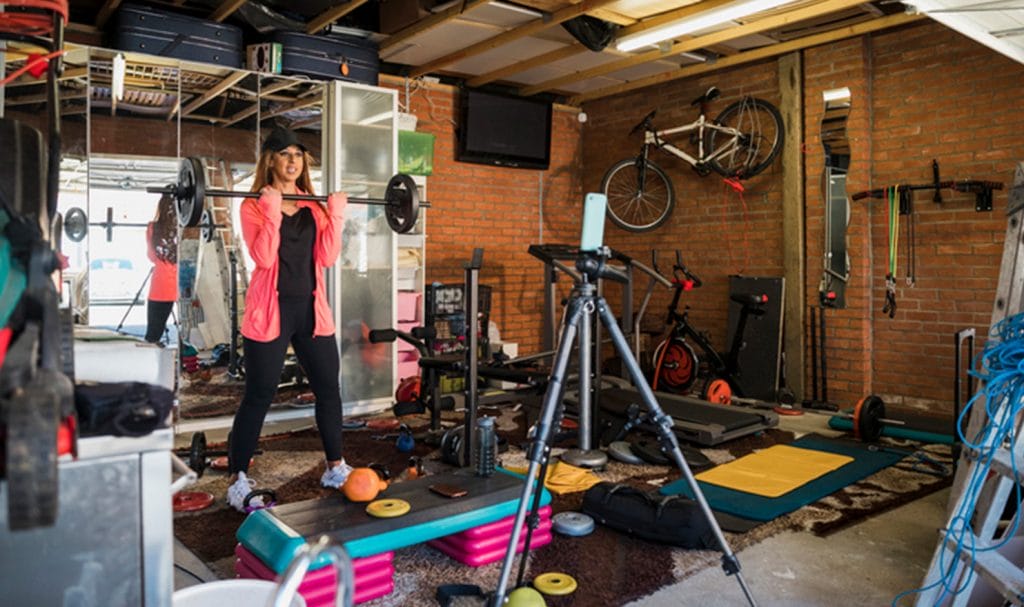Taking on more clients usually means putting in more hours, but what if you could increase your client base and your income while decreasing your hours?
The answer is online personal training.
This gives trainers the unique opportunity to develop an online training program and more seamlessly go from in-person to on-screen programs.
If you already have clients, then you have a good foundation to start your online client base with them. You just need to start a hybrid personal training program and follow a client transition plan.
Let’s look at how you can get started on a personal trainer client transition plan.
What Is Hybrid Personal Training?
Hybrid personal training is the method of combining in-person training with online sessions.
Typically, you and your client will choose how often you want to still meet in-person. Online training and virtual tools are then used to supplement the remaining time not spent face-to-face. Clients are able to stick to their fitness goals in a more independent format and trainers now have more time to take on new clients and grow their business.
The online training portion can be approached one of two ways. Either you can give clients a list of exercises and pre-recorded workout videos, or you can virtually train in real time through a video call. You can also conduct regular check-ins through video chats and phone calls, or through email, messaging, and online surveys. Do what feels right for your business and your clients.
Hybrid personal training is especially helpful when you currently train all in-person and want to move into an online business model. You can use hybrid training to slowly phase yourself and your current clients into online training. This is a great way to test out the online training model for your business and perfect your program with client feedback.

Prepare To Transition Current Clients
Before you can jump into a hybrid personal training model, you will need to do some work ahead of time. Your clients will need some online materials to get started, and having a plan for them to follow will make the transition to hybrid and online training easier for you and them.
At the very least, a client’s transition plan should include:
- An outline of the client’s schedule
- Instructions on how to complete online training
- A list of required equipment, goals, or meal plans
- Pre-recorded workout videos (if necessary)
- A way to communicate and receive feedback
One of the most important things to remember during this is to be open and transparent with your clients about your desire to move into an online program. A virtual fitness trainer may not be for everyone, so be aware you may have a handful of clients you still train exclusively in-person or who you lose to other trainers.
Clients who do not want to transition to a hybrid or online training program may need a plan on how to begin working with a new in-person trainer. While you would be losing them as a client, you can still maintain a positive relationship with them by recommending new trainers and keeping in contact. This small effort will give you a respectable reputation and could lead you to a new set of clients looking for an online trainer.
“Do I need to have an online video library completed before transitioning clients?”
The choice is yours! If you have the time to make videos while still training in-person clients, then this could be a good opportunity to test out online workout programs you have created. Not all of your clients may enjoy the idea of an online, independent fitness program, so use your own discretion on who you would still like to work with fully in-person.
For those who need to make the time to film their own videos, or simply want to run all their sessions virtually, then you don’t need to film anything ahead of time. You will need to make a plan on how you want to train your clients so they know what to expect and any software they may need to download ahead of your first virtual session.

Create A Personal Trainer Client Transition Plan
Once your clients have instructions and materials to follow, you need to make your own plan of action. Here’s how you can move your clients from in-person, to hybrid, and into an online personal training program in seven steps.
#1. Invite Your Top Clients
Organize a list of your current clients with the most loyal at the top. These clients are more likely to try a hybrid and online training model because they value your advice, support, and services. You are also more excited to work with them and know they will bring a positive attitude. This can help make the process less stressful for you. Start by inviting your top clients to try a hybrid schedule, and work down your list as you grow your online business.
#2. Test, Test, Test!
This is your chance to test different processes and find a structure that works best for you. See if you prefer a live-training style or pre-recorded videos. Try written workout plans versus full online programs, or a combination of both. Test out different locations for you to film at. Experiment with different benefits or features you might want to offer. Take advantage of this time to create a program you love, can maintain, and are able to scale.
#3. Track The Process
With every decision you make in your business, take notes of what is working and what isn’t. Everything from how you communicate with clients, where you film your videos, and what kinds of software you use to track payments. If something isn’t working for you or your clients, you can adjust your process. This also helps you make future decisions for your business based on your past experiences.
#4. Look For Common Questions
As you work with your clients, take note of the common questions you hear them ask. Maybe they struggle with accessing certain workout files or don’t understand how to complete certain workouts. These questions are excellent pointers for ways you can improve your program. Find ways to address and answer common questions within your material—such as adding clearer instructions, adding videos, or finding a different platform to host your program.
#5. Gather Important Feedback
While you work on creating smaller details for your programs, such as pricing, additional features, and website design, take some time to gather feedback on it. Your clients, and even other trainers, can help you gauge the quality and effectiveness of your work. This is especially helpful when it comes to pricing your online packages.
#6. Build Your Online Business
Because your new hybrid training schedule allows you to have some free time, you should plan to spend it on your new business model. This is your opportunity to apply the results of your tests, film and edit videos, incorporate feedback, establish branding, build out a marketing plan, and put finishing touches on everything. Use this time to arrange for the launch of your online business and prepare to start advertising to new potential clients.
#7. Decrease In-Person Sessions
Once you are ready to make the full switch to online personal training, you can start moving your hybrid clients into online clients. Then work with any remaining in-person clients to move through the hybrid to online process. You may find some clients do not want to train virtually, so you can still have a few in-person sessions or help them find new trainers.

Additional Tips
Because you are not in each client’s home as they virtually train with you, there will be some roadblocks you encounter. Here are a few of our tips to help you transition into online personal training with your current clients.
Establish Workout Equipment
If your workouts require any equipment, such as weights, mats, or resistance bands, be sure to provide a list of the items a client would need. Have your clients give you feedback how effective the equipment is, or what other equipment would have been useful for them.
Keep in mind not everyone might be able to find or purchase all of the necessary equipment. They may also have disabilities preventing them from using the equipment to the full extent. Look for modified uses for equipment, or easy replacements with items found around the home.
Stay Connected With Clients
One of the perks of online training is a client’s ability to stay tuned in with their fitness plan 24/7. Instead of waiting to ask you questions at your next in-person session, a client could message you for advice, access their goals, view a schedule, and even browse through additional health and fitness documents you provide for them.
Making yourself available to clients allows you to build a relationship with them to better their experience and better your programs. Whether you conduct face-to-face calls, utilize email and text messaging, or use a chat system, this personalizes your brand and adds value to your services. You can even use this opportunity to receive feedback on your programs and improve your systems based on client’s remarks.
Find Your “Freedom Number”
Jonathan Goodman, founder of the Personal Trainer Development Center, shared an important concept to consider when moving from in-person to online training. He encourages trainers to find a “Freedom Number.” Having used this process himself to start the PTDC, it’s a strategic way to free up extra time with your current business model so you can focus on your new online model—all without cutting your income.
To calculate your “Freedom Number,” you want to take your essential costs (your everyday life and business budget) and subtract any continued funds (clients staying in-person and other passive income sources). This is how much you need to make to step away from current business activities, and is a great figure to use as your target income for online personal training.
Get Online Personal Trainer Insurance
It’s easy to see why you may need insurance if you’re working in a gym, but why would you need insurance if you train online? Just because you are not physically in the same place as a client doesn’t mean they can’t get hurt. Accidents can still occur while someone is following your instruction, and they can hold you responsible for it.
You also invest in a lot of equipment to film and edit videos, video call clients, rent or create an in-home training space, and purchasing equipment. With Insurance Canopy, you can insure these types of items—as well as protect yourself from costly injury claims. Our policies work with you in the gym, in the studio, online, and at home. Wherever you choose to train, do it with Insurance Canopy’s personal trainer insurance.

“How To Become An Online Personal Trainer” is a nine-part series by Insurance Canopy outlining tips and tricks to help you take your training to the next level. Check out the rest of the series below!
Part One: Finding Your Virtual Training Space
Part Two: Scaling Your Personal Training Business
Part Three: Building Your Exercise Library
Part Four: Creating Online Personal Training Packages
Part Six: Gaining New Clients
Part Seven: Data Documentation & Client Organization
Part Eight: Protecting Your Business
Part Nine: 5 Additional Tips For Continued Success





